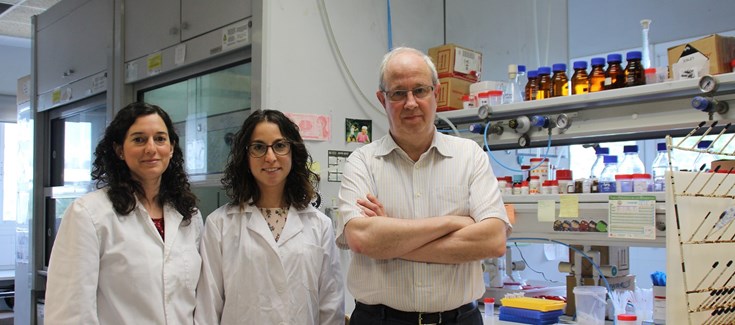Infections such as Candiasis will be detected in 30 minutes
Ramón Martínez Máñez, Elena Aznar and Ángela Ribes, researchers of Unit 26 of NANBIOSIS, NMR: Biomedical Applications II, in collaboration with researchers from the Universitat Politècnica de València, with the Universitari i Politècnic La Fe Hospital and the Rovira i Virgili University, have developed a new material that allows to detect quickly and with a high sensitivity infections caused by Candida albicans, a type of fungus that can be found in different biological fluids, causing opportunistic infections such as Candidemia or Invasive Candidiasis.
According to Javier Pemán, head of section and head of the Mycology Unit of the Microbiology Service of the Hospital Universitari i Politècnic La Fe,” infections are difficult to identify early, very frequent in most Intensive Care Units (ICUs) and represent an important challenge in critical patients”.
Currently, these infections are diagnosed by culturing the biological fluid to be studied and subsequent identification of yeast isolated by different microbiological techniques whose results can take between 3 and 4 days. Meanwhile, with this new material and method – patented by the UPV, the CIBER, the Hospital La Fe and the URV – the diagnostic time is reduced to only 30 minutes.
“The tests can be carried out quickly and practically in the same consultation in which the patient sample is taken, significantly reducing the equipment necessary to detect the presence of Candida albicans. Our work facilitates the diagnosis and medical decision-making, through the use of a powerful and fast tool to detect the infection”, says Ramón Martínez Máñez, scientific director of the CIBER-BBN and director of the IDM Institute at the UPV, as well as scientific director of NANBIOSIS U26.
Nanoporous films with molecular doors
The material developed by the CIBER-BBN research gourp, led by Ramón Martínez Máñez, is about nanoporous alumina films that incorporate “molecular doors” based on oligonucleotides. The characterization has been carried out in Unit 26 of NANBIOSIS, NMR: Biomedical Applications II.
“They are constituted by a porous inorganic support that is loaded with a dye and by simple strands of DNA. These strands are anchored to the surface of the support and act as “molecular doors” that inhibit the release of the indicator “, explains Ramón Martínez Máñez.
In addition, according to Professor Lluis Marsal, from the Rovira i Virgili University, the type of support used greatly simplifies the methodology of the experiment.
On how to detect the infection, Professor Martínez Máñez explains that the simple strands of DNA are selected taking into account a specific sequence of Candida albicans.
“When the presence of the DNA of this fungus is noticed, it interacts with the molecular door, the pores open and that is when the release of the dye that is inside the nanoporous support takes place, thus detecting the infection,” adds Elena Aznar , researcher of the CIBER-BBN in the IDM-UPV.
The diagnostic material is now in the clinical validation phase, thanks to the funding obtained through the CANDI-GATE project granted by the Polytechnic University of Valencia and the La Fe Health Research Institute and led by M. Angeles Tormo and Elena Aznar and through the CANDI-EYE valuation project granted by the CIBER-BBN and led by Elena Aznar.
Patent of reference:
“Porous material for the detection of Candida albicans, diagnostic method that uses it and method of preparation of it”. Spanish application pattent P201731069 2017-09-05.









